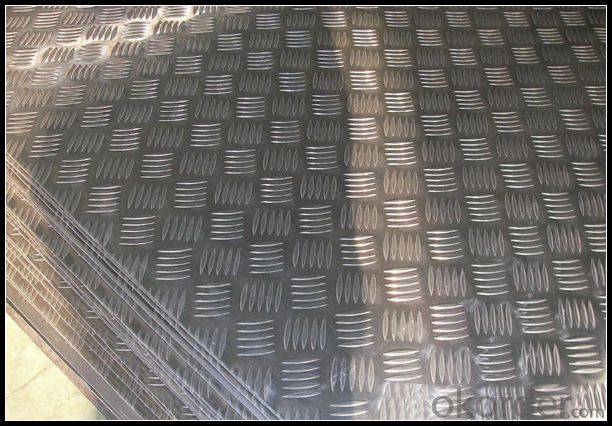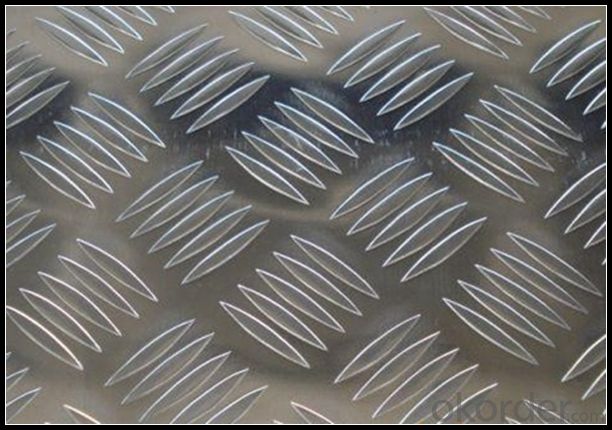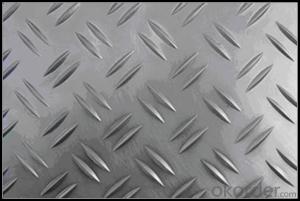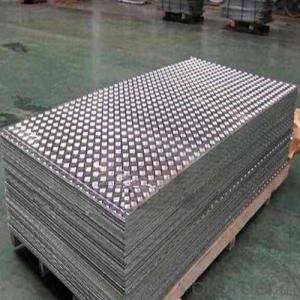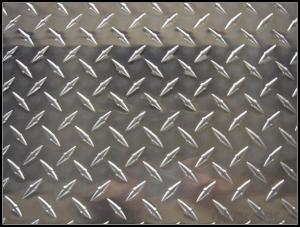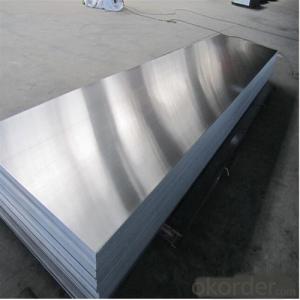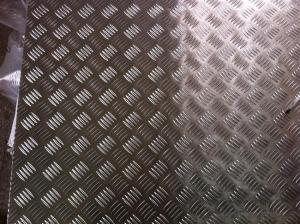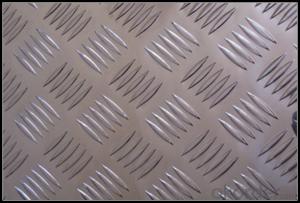Aluminum Perforated Sheets - Embossed Aluminum Sheet 5052 for Anti-Slipped Step
- Loading Port:
- Shanghai
- Payment Terms:
- TT OR LC
- Min Order Qty:
- 5 m.t.
- Supply Capability:
- 100000 m.t./month
OKorder Service Pledge
OKorder Financial Service
You Might Also Like
Specification
1.Structure of Embossed Aluminum Sheet 5052 for Anti-slipped Step
Aluminum Sheets are strengthened and cut from raw materials with different alloys, such as AA5005, AA5052, etc. They are easy for processing in different shapes, good in intensity and can be quickly installed. Aluminium Sheets for Energy Saving Curtain Walls are good in energy saving, weather resistance, fire resistance, easy for maintenance and with many colors.
Aluminium Sheets for Energy Saving Curtain Walls are widely used in construction of metal walls, metal ceilings, car decoration, advertizing panels, etc.
2.Main Features of Embossed Aluminum Sheet 5052 for Anti-slipped Step
•High intensity
•Easy to be processed and shaped
•Weather resistance
•Anti-pollution & environment protection
3. Embossed Aluminum Sheet 5052 for Anti-slipped Step Images
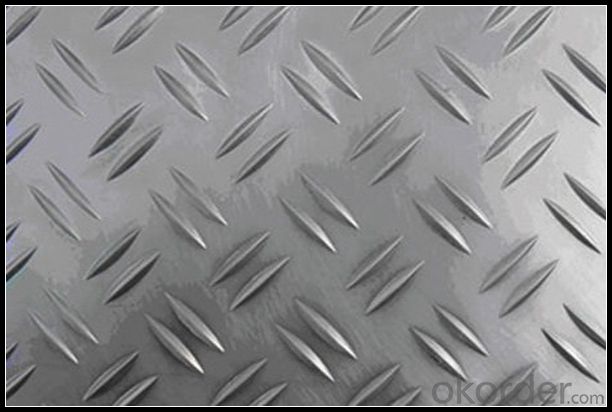
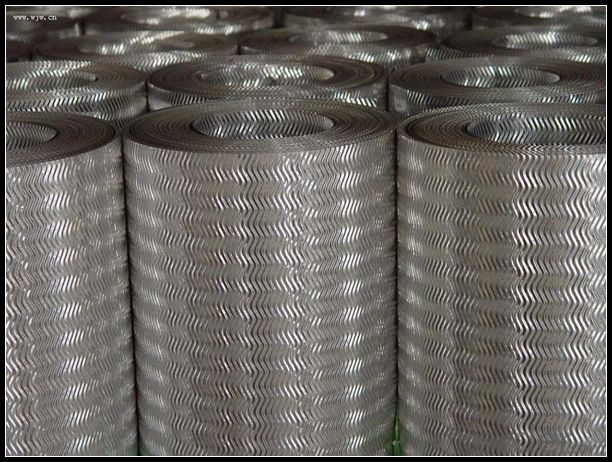
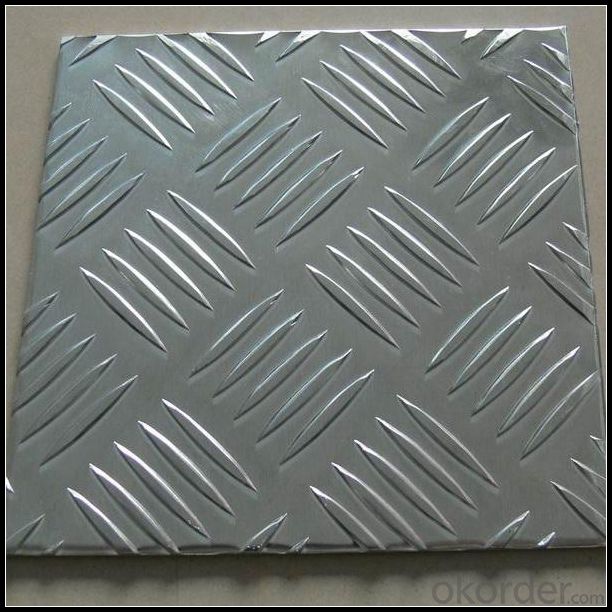
4.Specification of Aluminum Sheet 6061 for Window And Door System
Alloy Number | AA5XXX |
Temper | H12, H14, H16, H18, H22, H24, H26, H32, HO, F |
Thickness | 0.1mm – 500mm |
Width | 10mm- 2200mm |
Standard | GB/T3880-2006, ASTM, ISO, EU standard |
5.FAQ
A.What about inspections to guarantee quality?
For each order for Aluminum Sheets with Mill Finished Surface AA5XXX, we will arrange strict inspection for raw materials, inspection during production and inspection for finished goods.
With requirement of customers, we also can arrange the third party inspection.
B.What about delivery?
We will put order for Aluminum Sheets with Mill Finished Surface AA5XXX in production schedule after order gets confirmed against copy of TT or L/C. Normally it takes about one month for production. Exact shipment schedule is different based on different sizes and quantity.
C.What is the MOQ?
5 tons for each size.
D. Where have you exported aluminium sheets?
We have exported aluminum sheets to many countries. Main markets include South East Asia, Middle East, North America, South America, etc.
- Q: What are the different alloys available for aluminum sheets?
- There are several alloys available for aluminum sheets, including 1100, 3003, 5052, and 6061. Each alloy has different properties and characteristics, making them suitable for various applications.
- Q: Can aluminum sheets be utilized as a material for constructing caravan roofs?
- <p>Yes, aluminum sheets can be used for caravan roofs. They are lightweight, durable, and resistant to corrosion, making them an ideal material for this purpose. Aluminum sheets are easy to install and maintain, and they can also reflect heat, helping to keep the interior of the caravan cooler. However, it's important to ensure that the aluminum sheets are of good quality and properly sealed to prevent water ingress and to maintain structural integrity over time.</p>
- Q: What are the different methods of finishing aluminum sheet edges?
- Depending on the desired outcome and application, there are multiple techniques available to finish aluminum sheet edges. One option is deburring, which involves removing sharp or rough edges from the aluminum sheet. This can be accomplished with tools like files, sandpaper, or specialized deburring machines. Deburring not only enhances the appearance of the edges but also helps prevent potential injuries or accidents caused by sharp edges. Another method is chamfering, where a beveled edge is created on the aluminum sheet. This can be done using chamfering tools or by carefully filing or sanding the edges at a specific angle. Chamfering is often performed to improve the aesthetics of the aluminum sheet and make it easier to handle and assemble. Additionally, edge rounding is a technique that involves smoothing the edges of the aluminum sheet to give them a rounded or curved profile. Sanders, grinders, or specialized edge rounding machines can be used for this purpose. Edge rounding not only enhances the visual appeal of the aluminum sheet but also reduces the risk of injury from sharp edges. Moreover, anodizing is a widely used finishing method for aluminum sheet edges. It involves creating a protective oxide layer on the aluminum surface through an electrochemical process. Anodizing not only improves the corrosion resistance of the aluminum but also offers a range of color options for the edges, allowing for customization and improved aesthetics. Lastly, powder coating is another viable method for finishing aluminum sheet edges. It entails applying a dry powder onto the aluminum surface and then heating it to create a durable and decorative finish. Powder coating provides a wide variety of colors, textures, and finishes, allowing for customization and enhanced visual appeal. In conclusion, the choice of finishing method for aluminum sheet edges depends on factors such as the desired appearance, functionality, and application requirements. It is crucial to consider these factors and seek expert advice to determine the most suitable method for a specific project.
- Q: Are aluminum sheets suitable for electrical bus bars?
- Yes, aluminum sheets can be suitable for electrical bus bars in certain applications. Aluminum has several properties that make it a viable option for bus bars. Firstly, aluminum is a lightweight material, which can be advantageous in applications where weight reduction is important. Additionally, aluminum has good electrical conductivity, although it is not as conductive as copper. However, aluminum bus bars can still handle high electrical currents and are commonly used in power distribution systems. One downside of aluminum bus bars is that they have a higher resistance compared to copper bus bars. This means that they can generate more heat, especially under high current loads. To mitigate this issue, aluminum bus bars are often designed with larger cross-sectional areas to reduce resistance and dissipate heat more effectively. Another challenge with aluminum bus bars is their susceptibility to oxidation and corrosion. This can be addressed by applying protective coatings or using alloys with better corrosion resistance. It is also important to ensure proper insulation and avoid contact with dissimilar metals to prevent galvanic corrosion. In summary, aluminum sheets can be suitable for electrical bus bars, especially in applications where weight reduction is important. However, careful consideration must be given to factors such as electrical conductivity, heat dissipation, and corrosion resistance to ensure optimal performance and longevity of the bus bars.
- Q: Can aluminum sheets be easily shaped or bent?
- Indeed, aluminum sheets possess a remarkable capability to be effortlessly molded or flexed. Renowned for its exceptional malleability and ductility, aluminum exhibits a remarkable propensity to be readily fashioned into diverse contours and curves. The manipulation of this versatile metal can be accomplished through an assortment of techniques, encompassing rolling, pressing, and even manual utilization of tools. Given its pliability, aluminum emerges as the preferred choice within industries such as automotive, aerospace, and construction, wherein the fabrication of intricate shapes and bends is a common necessity. Moreover, the lightweight nature and inherent resistance to corrosion further enhance aluminum's suitability for shaping and bending endeavors.
- Q: Can aluminum sheets be bent or formed without cracking or breaking?
- Yes, aluminum sheets can be bent or formed without cracking or breaking, as long as proper techniques such as annealing and using appropriate tooling are employed.
- Q: What are the different types of surface treatments available for painted aluminum sheets?
- There are several different types of surface treatments available for painted aluminum sheets. These treatments are designed to enhance the appearance and durability of the aluminum, as well as provide protection against corrosion and other forms of damage. One common type of surface treatment is anodizing. Anodizing involves immersing the aluminum sheets in an electrolytic solution and passing an electric current through them. This process creates a protective oxide layer on the surface of the aluminum, which not only improves its corrosion resistance but also provides a base for painting or other decorative finishes. Another popular surface treatment for painted aluminum sheets is powder coating. Powder coating involves applying a dry powder to the surface of the aluminum and then heating it to form a tough, protective layer. This coating is known for its durability, resistance to fading and chipping, and ability to provide a wide range of colors and finishes. In addition to anodizing and powder coating, there are also other surface treatments available for painted aluminum sheets. These include chemical conversion coating, which involves applying a chemical solution to the aluminum to create a protective layer, and laminate coatings, which involve applying a thin film or laminate to the surface for added protection and decoration. Overall, the different types of surface treatments available for painted aluminum sheets offer a variety of benefits, including enhanced appearance, improved durability, and increased resistance to corrosion. The choice of surface treatment will depend on the specific requirements and desired outcomes for the aluminum sheets in question.
- Q: Can aluminum sheets be used for automotive applications?
- Yes, aluminum sheets can be used for automotive applications. Aluminum is a lightweight and corrosion-resistant material, making it ideal for various automotive components. It is commonly used in the construction of car bodies, engine parts, wheels, and other structural components. Aluminum sheets offer excellent strength-to-weight ratio, which helps improve fuel efficiency and overall performance of vehicles. Additionally, aluminum has good thermal conductivity, allowing for effective heat dissipation in automotive applications. Overall, the use of aluminum sheets in automotive manufacturing has become increasingly popular due to its numerous advantages.
- Q: Are aluminum sheets resistant to abrasion?
- Yes, aluminum sheets are generally resistant to abrasion due to their hardness and durability.
- Q: I think I remember that this is true of aluminum foil. When it's charged, it'll push away from itself, I know. Why do magnets have seemingly no effect?
- Aluminum is a non-ferrous metal. Ferrous metals contain Iron which is magnetic. When aluminum has a charge applied to it, it acts like any conductor would, the charge has magnetic properties. the aluminum is still not magnetic, but it acts like a magnet due to the charge.
Send your message to us
Aluminum Perforated Sheets - Embossed Aluminum Sheet 5052 for Anti-Slipped Step
- Loading Port:
- Shanghai
- Payment Terms:
- TT OR LC
- Min Order Qty:
- 5 m.t.
- Supply Capability:
- 100000 m.t./month
OKorder Service Pledge
OKorder Financial Service
Similar products
Hot products
Hot Searches
Related keywords


